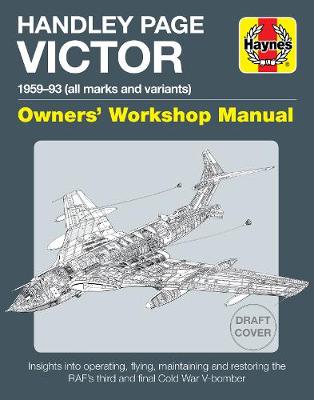The Handley Page Victor was the third and final V-bomber to be operated by the RAF during the Cold War as part of the UK's airborne nuclear deterrent, carrying the Blue Steel stand-off nuclear weapon. It also served as a strategic reconnaissance platform and as an air-to-air refuelling tanker. This manual showcases two former Falklands and Gulf War veteran aircraft.
The Victor was one of three new types of aircraft ordered for the re-equipment of the RAF under the "V"-bomber programme. It was designed to a similar requirement as the Avro Vulcan but represented a different if equally bold approach to the problem of producing a four-jet bomber capable of carrying heavy loads at high subsonic speeds for great distances at altitudes up to 50,000ft.
The prototype first flew on 24 December 1952 with the first production aircraft flying on 1 February 1956. The first Victor B.1 entered service in November 1957 and a total of 49 B.1 and B.1A aircraft were delivered to the RAF, equipping four squadrons and the OCU.
With the demise of the Valiant in 1965, the Victor was chosen as a replacement for the RAF's AAR capability, initially as a two-point tanker but later as a three-point tanker. All conversions were completed by Avro at Woodford.
Meanwhile, the Victor B.1 was superseded by the significantly improved performance of the B.2, which was designed to carry the Blue Steel stand-off nuclear weapons. The first production B.2 aircraft made its first flight in February 1959 and entered service in October 1961. In addition to the B.2 variant, the B/SR.2 entered service with 543 Squadron at Wyton in December 1965 and became Bomber Command's standard strategic reconnaissance aircraft in place of the Valiant B(PR).1.
By the end of 1968, the Victor ceased to serve as a bomber as it was not coping with the low-level stresses - instead, it was replaced by the Vulcan in this role. However, the Victor B.2 aircraft were to find and new and important role within the RAF in which they would remain in service into the 1990s.
The Victor K.2 was evolved as a replacement for the older K.1 and K.1A tanker aircraft which had entered service back in 1965. The first K.2 conversion made its first flight at Woodford on 1 March 1972 and entered service with 55 Squadron in July 1975. Originally, 29 conversions had been ordered but this was reduced by the Treasury and only 24 were eventually completed.
It was during the Falklands Conflict that the Victor K.2 made such an outstanding contribution to the campaign, flying over 3,000-hours. Victor aircraft based at Ascension Island made more than 600 air-to-air refuelling sorties in support of Vulcan, Nimrod, Hercules and Harrier aircraft. However, their most famous contribution was the air-to-air refuelling of the single Vulcan bombers during the 'Black Buck' operations which highlighted their effective career.
Later, the Victor K.2 played a pivotal role during Operation Granby during Gulf War 1. However, this activity in theatre drained the remaining life from the already tired airframes and the end of the Victor was in sight. The last of the V-bombers in RAF service, the Victor K.2 was finally withdrawn in October 1993, being replaced by the VC10 and Tristar tanker aircraft.
The book will feature two former Falklands and Gulf War veteran aircraft:
* XL231 'Lusty Lindy' maintained in a 'running' order at the Yorkshire Air Museum at Elvington;
* XM715 'Teasin Tina/Victor Meldrew' maintained in a 'running' order with the British Aviation Heritage Centre at Bruntingthorpe.
- ISBN10 1785216791
- ISBN13 9781785216794
- Publish Date 24 June 2021
- Publish Status Cancelled
- Publish Country GB
- Publisher Haynes Publishing Group
- Imprint J H Haynes & Co Ltd
- Format Hardcover
- Pages 192
- Language English
